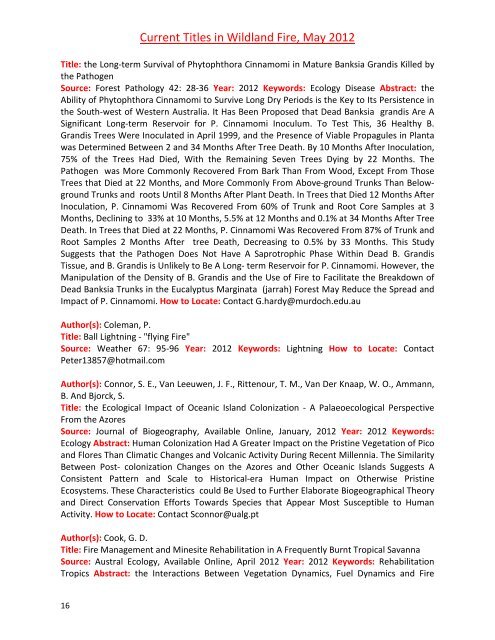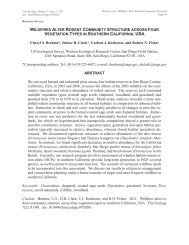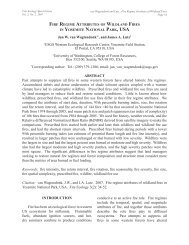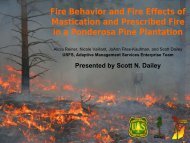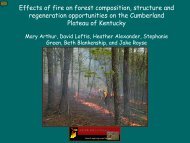Current Titles in Wildland Fire, May 2012 - Association for Fire Ecology
Current Titles in Wildland Fire, May 2012 - Association for Fire Ecology
Current Titles in Wildland Fire, May 2012 - Association for Fire Ecology
Create successful ePaper yourself
Turn your PDF publications into a flip-book with our unique Google optimized e-Paper software.
<strong>Current</strong> <strong>Titles</strong> <strong>in</strong> <strong>Wildland</strong> <strong>Fire</strong>, <strong>May</strong> <strong>2012</strong><br />
Title: the Long-term Survival of Phytophthora C<strong>in</strong>namomi <strong>in</strong> Mature Banksia Grandis Killed by<br />
the Pathogen<br />
Source: Forest Pathology 42: 28-36 Year: <strong>2012</strong> Keywords: <strong>Ecology</strong> Disease Abstract: the<br />
Ability of Phytophthora C<strong>in</strong>namomi to Survive Long Dry Periods is the Key to Its Persistence <strong>in</strong><br />
the South-west of Western Australia. It Has Been Proposed that Dead Banksia grandis Are A<br />
Significant Long-term Reservoir <strong>for</strong> P. C<strong>in</strong>namomi Inoculum. To Test This, 36 Healthy B.<br />
Grandis Trees Were Inoculated <strong>in</strong> April 1999, and the Presence of Viable Propagules <strong>in</strong> Planta<br />
was Determ<strong>in</strong>ed Between 2 and 34 Months After Tree Death. By 10 Months After Inoculation,<br />
75% of the Trees Had Died, With the Rema<strong>in</strong><strong>in</strong>g Seven Trees Dy<strong>in</strong>g by 22 Months. The<br />
Pathogen was More Commonly Recovered From Bark Than From Wood, Except From Those<br />
Trees that Died at 22 Months, and More Commonly From Above-ground Trunks Than Belowground<br />
Trunks and roots Until 8 Months After Plant Death. In Trees that Died 12 Months After<br />
Inoculation, P. C<strong>in</strong>namomi Was Recovered From 60% of Trunk and Root Core Samples at 3<br />
Months, Decl<strong>in</strong><strong>in</strong>g to 33% at 10 Months, 5.5% at 12 Months and 0.1% at 34 Months After Tree<br />
Death. In Trees that Died at 22 Months, P. C<strong>in</strong>namomi Was Recovered From 87% of Trunk and<br />
Root Samples 2 Months After tree Death, Decreas<strong>in</strong>g to 0.5% by 33 Months. This Study<br />
Suggests that the Pathogen Does Not Have A Saprotrophic Phase With<strong>in</strong> Dead B. Grandis<br />
Tissue, and B. Grandis is Unlikely to Be A Long- term Reservoir <strong>for</strong> P. C<strong>in</strong>namomi. However, the<br />
Manipulation of the Density of B. Grandis and the Use of <strong>Fire</strong> to Facilitate the Breakdown of<br />
Dead Banksia Trunks <strong>in</strong> the Eucalyptus Marg<strong>in</strong>ata (jarrah) Forest <strong>May</strong> Reduce the Spread and<br />
Impact of P. C<strong>in</strong>namomi. How to Locate: Contact G.hardy@murdoch.edu.au<br />
Author(s): Coleman, P.<br />
Title: Ball Lightn<strong>in</strong>g - "fly<strong>in</strong>g <strong>Fire</strong>"<br />
Source: Weather 67: 95-96 Year: <strong>2012</strong> Keywords: Lightn<strong>in</strong>g How to Locate: Contact<br />
Peter13857@hotmail.com<br />
Author(s): Connor, S. E., Van Leeuwen, J. F., Rittenour, T. M., Van Der Knaap, W. O., Ammann,<br />
B. And Bjorck, S.<br />
Title: the Ecological Impact of Oceanic Island Colonization - A Palaeoecological Perspective<br />
From the Azores<br />
Source: Journal of Biogeography, Available Onl<strong>in</strong>e, January, <strong>2012</strong> Year: <strong>2012</strong> Keywords:<br />
<strong>Ecology</strong> Abstract: Human Colonization Had A Greater Impact on the Prist<strong>in</strong>e Vegetation of Pico<br />
and Flores Than Climatic Changes and Volcanic Activity Dur<strong>in</strong>g Recent Millennia. The Similarity<br />
Between Post- colonization Changes on the Azores and Other Oceanic Islands Suggests A<br />
Consistent Pattern and Scale to Historical-era Human Impact on Otherwise Prist<strong>in</strong>e<br />
Ecosystems. These Characteristics could Be Used to Further Elaborate Biogeographical Theory<br />
and Direct Conservation Ef<strong>for</strong>ts Towards Species that Appear Most Susceptible to Human<br />
Activity. How to Locate: Contact Sconnor@ualg.pt<br />
Author(s): Cook, G. D.<br />
Title: <strong>Fire</strong> Management and M<strong>in</strong>esite Rehabilitation <strong>in</strong> A Frequently Burnt Tropical Savanna<br />
Source: Austral <strong>Ecology</strong>, Available Onl<strong>in</strong>e, April <strong>2012</strong> Year: <strong>2012</strong> Keywords: Rehabilitation<br />
Tropics Abstract: the Interactions Between Vegetation Dynamics, Fuel Dynamics and <strong>Fire</strong><br />
16


